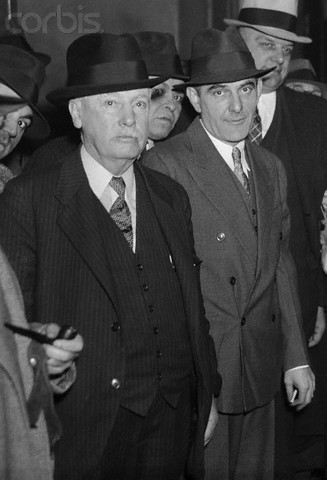
In 1934 the United States was flooded with counterfeit bills. The secret service believed the man responsible was William Watts, a former pharmacist, who started counterfeiting whiskey labels during prohibition. The government didn't know how to find Watts, but knew his contact man was Count Victor Lustig.
Lustig was arrested after a stakeout, and confirmed that Watts was the counterfeiter. Lustig claimed that he had nothing to do with this scam, yet he had a key for a locker in Times Square that held a set of plates and $51,000 in phony money. Lustig was sent to the federal house of detention in New York City. Almost immediately the funny money supply dried up. The police thought they finally had nailed Lustig. Lustig broke out of jail the day before his trial. His escape was carefully planned out. Lustig noticed that when the attendants brought clean bed sheets to the cells, they would ask how many beds were full and hand over the required number of sheets. When they came to collect the dirty sheets, they never counted how many were returned. A couple of weeks before Lustigs escape, he simply added one to the number of occupied beds and accumulated nine sheets that he stored in a slit in his mattress. At night when other prisoners were listing to a radio show, Lustig tore the sheets into long strips and made a rope.
As part of the daily routine in prison, the prisoners were taken to the roof at noon for exercises. On the day of Lustigs escape, he claimed that he was ill and stayed behind. He then went down the hall to the bathroom and cut through the wire screening with a pair of wire cutters. He then securely fastened his rope to the third floor window and stepped outside onto a six inch ledge. He then proceeded to vigorously clean the windows with his white cloth. Suddenly the cleaning rag extended out into a long rope and Lustig lowered himself to the street below. Many thought he had fallen from the ledge, but he quickly bounced to his feet, took a bow, and then disappeared into the city.
Lustig was caught twenty seven days later in Pittsburgh Pennsylvania. His trial started December 5, 1935. The star witness was William Watts who relayed every detail of the counterfeiting scheme. Lustig interrupted the trial and plead guilty. Lustig and Watts were both sentenced to fifteen years in prison. Lustig was sentenced and additional five years for his escape and was sent to Alcatraz. On March 9, 1947, Lustig contracted pneumonia and died 36 hours later at the age of fifty seven, thus ending the career of one of the most notorious con artists.